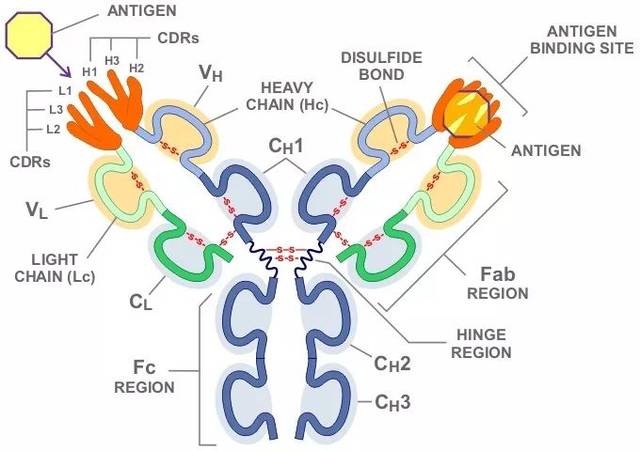Product Name :
CLIC1 polyclonal antibody Background :
Chloride intracellular channel 1 (CLIC1), also referred to as NCC27, is a member of the highly conserved family of chloride ion channels that function in both soluble and integral membrane forms. CLIC1 is a monomeric protein that contains a redox-active site similar to glutaredoxin; it functions as a anionselective channel. CLIC1 forms a dimer when oxidized and is then able to form chloride ion channels in bilayers and vesicles, whereas a reducing environment prevents this from occurring. Insulin concentration also plays a role in CLIC1 regulation, and the hormone may cause a subnuclear relocalization of CLIC1. CLIC1 is associated with macrophage activation; a downregulation of CLIC1 function prevents TNFα release induced by β-Amyloid protein (A-β) stimulation. This suggests a role for CLIC1 in several neurodegenerative processes, such as Alzheimer’s disease, a syndrome characterized by an accumulation of A-β. Product :
Rabbit IgG, 1mg/ml in PBS with 0.02% sodium azide, 50% glycerol, pH7.2 Storage&Stability :
Store at 4°C short term. Aliquot and store at -20°C long term. Avoid freeze-thaw cycles. Specificity :
CLIC1 polyclonal antibody detects endogenous levels of CLIC1 protein. Immunogen :
Recombinant Protein corresponding to a sequence within amino acids 42-241 of human CLIC1(NP_001279.2). Conjugate :
Unconjugated Modification :
Unmodified
CLIC1 polyclonal antibody Background :
Chloride intracellular channel 1 (CLIC1), also referred to as NCC27, is a member of the highly conserved family of chloride ion channels that function in both soluble and integral membrane forms. CLIC1 is a monomeric protein that contains a redox-active site similar to glutaredoxin; it functions as a anionselective channel. CLIC1 forms a dimer when oxidized and is then able to form chloride ion channels in bilayers and vesicles, whereas a reducing environment prevents this from occurring. Insulin concentration also plays a role in CLIC1 regulation, and the hormone may cause a subnuclear relocalization of CLIC1. CLIC1 is associated with macrophage activation; a downregulation of CLIC1 function prevents TNFα release induced by β-Amyloid protein (A-β) stimulation. This suggests a role for CLIC1 in several neurodegenerative processes, such as Alzheimer’s disease, a syndrome characterized by an accumulation of A-β. Product :
Rabbit IgG, 1mg/ml in PBS with 0.02% sodium azide, 50% glycerol, pH7.2 Storage&Stability :
Store at 4°C short term. Aliquot and store at -20°C long term. Avoid freeze-thaw cycles. Specificity :
CLIC1 polyclonal antibody detects endogenous levels of CLIC1 protein. Immunogen :
Recombinant Protein corresponding to a sequence within amino acids 42-241 of human CLIC1(NP_001279.2). Conjugate :
Unconjugated Modification :
Unmodified
-
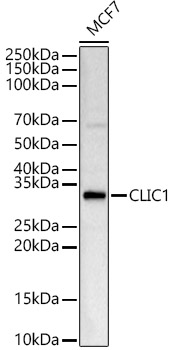 Western blot analysis of lysates from MCF7 cells, using CLIC1 pAb at 1:1000 dilution.
Western blot analysis of lysates from MCF7 cells, using CLIC1 pAb at 1:1000 dilution. -
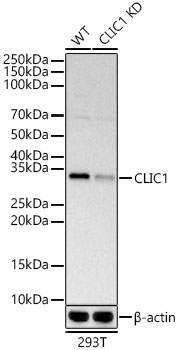 Western blot analysis of lysates from wild type(WT) and CLIC1 knockdown (KD) HeLa cells, using CLIC1 pAb at 1:1000 dilution.
Western blot analysis of lysates from wild type(WT) and CLIC1 knockdown (KD) HeLa cells, using CLIC1 pAb at 1:1000 dilution. -
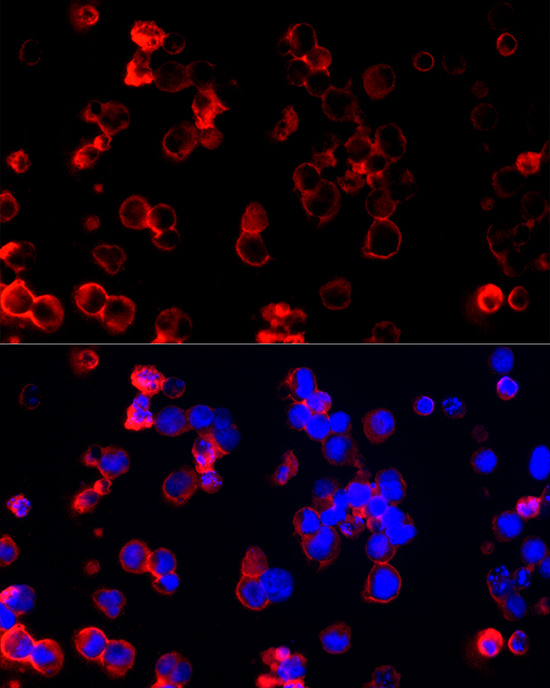 Western blot analysis of lysates from wild type(WT) and CLIC1 knockdown (KD) HeLa cells, using CLIC1 pAb at 1:1000 dilution.
Western blot analysis of lysates from wild type(WT) and CLIC1 knockdown (KD) HeLa cells, using CLIC1 pAb at 1:1000 dilution. -
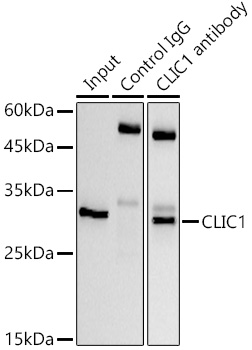 Western blot analysis of lysates from wild type(WT) and CLIC1 knockdown (KD) HeLa cells, using CLIC1 pAb at 1:1000 dilution.
Western blot analysis of lysates from wild type(WT) and CLIC1 knockdown (KD) HeLa cells, using CLIC1 pAb at 1:1000 dilution.
Bioworld Biotech only provide peptides for our antibodies and do not provide additional peptide customization services.
Price/Size :
USD 368/1mg/vial
Tips:
For phospho antibody, we provide phospho peptide(0.5mg) and non-phospho peptide(0.5mg).Describe :
Blocking peptides are peptides that bind specifically to the target antibody and block antibody binding. These peptide usually contains the epitope recognized by the antibody. Antibodies bound to the blocking peptide no longer bind to the epitope on the target protein. This mechanism is useful when non-specific binding is an issue, for example, in Western blotting (WB) and Immunohistochemistry (IHC). By comparing the staining from the blocked antibody versus the antibody alone, one can see which staining is specific; Specific binding will be absent from the western blot or IHC performed with the neutralized antibody.Formula:
Synthetic peptide was lyophilized with 100% acetonitrile and is supplied as a powder. Reconstitute with 0.1 ml DI water for a final concentration of 10 mg/ml.The purity is >90%,tested by HPLC and MS.
Storage:
The freeze-dried powder is more stable. For short time at 2-8°C. For long term storage store at -20°C.
Note :
This product is for research use only (RUO only). Not for use in diagnostic or therapeutic procedures.
 CLIC1 polyclonal antibody
CLIC1 polyclonal antibody  Datasheet
Datasheet COA
COA MSDS
MSDS SHIP
SHIP